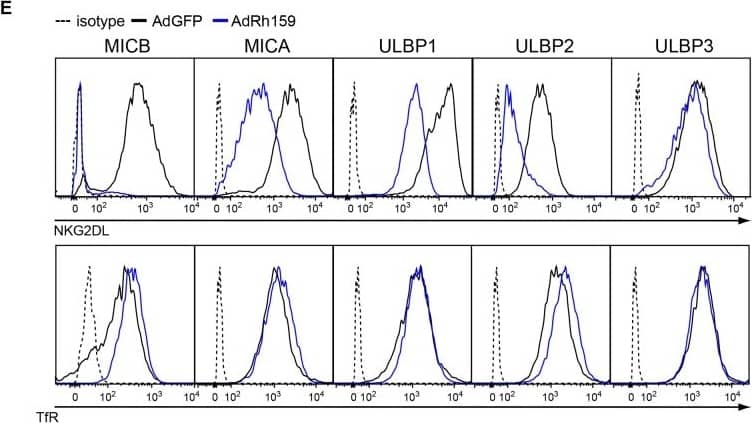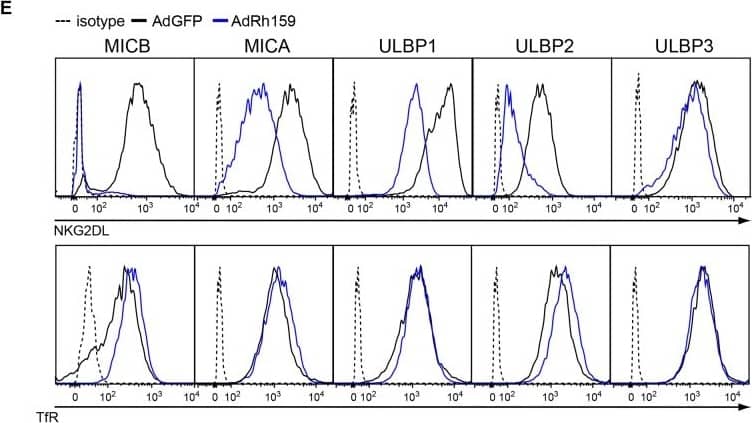Human ULBP-3 Antibody Summary
Gly27-Pro216
Accession # NP_078794
Applications
Please Note: Optimal dilutions should be determined by each laboratory for each application. General Protocols are available in the Technical Information section on our website.
Scientific Data
 View Larger
View Larger
Detection of Human ULBP-3 by Flow Cytometry Rh159 interferes with intracellular transport of NKG2DL.A) Association with Rh159 prevents intracellular transport of MICB. U373-MICB cells were transduced with adenovectors (MOI = 80) expressing either GFP (AdGFP) or FLAG-tagged Rh159 (AdRh159FL) under control of tetracycline-dependent transactivator provided by co-transduced AdtTA (MOI = 20). At 24 hpi cells were metabolically labeled for 30 min with [35S]cysteine + [35S]methionine. Upon chasing the label for the indicated times (h), cells were lysed and MICB was immunoprecipitated with anti–MICB mAb. Precipitates were either digested with EndoH (+) or mock treated (-) followed by SDS-PAGE and autoradiography. (S) indicates EndoH-deglycosylated proteins. B) Rh159 co-immunoprecipitates with MICB. U373-ULBP3 (ULBP3, left panel) or U373-MICB (MICB, right panel) cells were lysed at 48 h post-transduction with AdRh159FL (Rh159) or an adenovector expressing FLAG-tagged SVV ORF 61 (SVV61) used as a negative control. MICB and ULBP3 were immunoprecipitated with anti–MICB and anti-ULBP3 mouse and goat mAbs, respectively, then immunoblotted with mouse anti-FLAG mAb. The mouse IgG heavy chain (55kDa) is indicated (HC). Input lanes were loaded with 10% total lysate used in immunoprecipitation and immunoblotted with mAbs for FLAG and GAPDH. The results shown are representative of two independent experiments. C) Rh159 reduces steady state levels of MICB. U373-MICB cells were lysed at 48 h post-transduction with the indicated Ad-vectors. Lysates were digested with EndoH (+) or mock treated (-) then immunoblotted with mAbs for MICB, FLAG or GAPDH. Note that both MICB and Rh159 are EndoH sensitive consistent with ER localization. The results shown are representative of two independent experiments. D-E) Rh159 reduces surface expression of MICA, MICB, ULBP1 and ULBP2 but not ULBP3. U373-NKG2DL cells were transduced with AdRh159FL or AdGFP as in A) but for 48 h. Cells were then lysed and immunoblotted with mAbs for FLAG and GAPDH (D), or stained with antibodies specific for the indicated proteins, or isotype control (dotted) and analyzed by flow cytometry. The results shown are representative of three or more independent experiments. Image collected and cropped by CiteAb from the following open publication (https://pubmed.ncbi.nlm.nih.gov/27580123), licensed under a CC-BY license. Not internally tested by R&D Systems.
 View Larger
View Larger
Detection of Human ULBP-3 by Flow Cytometry Rh159 interferes with intracellular transport of NKG2DL.A) Association with Rh159 prevents intracellular transport of MICB. U373-MICB cells were transduced with adenovectors (MOI = 80) expressing either GFP (AdGFP) or FLAG-tagged Rh159 (AdRh159FL) under control of tetracycline-dependent transactivator provided by co-transduced AdtTA (MOI = 20). At 24 hpi cells were metabolically labeled for 30 min with [35S]cysteine + [35S]methionine. Upon chasing the label for the indicated times (h), cells were lysed and MICB was immunoprecipitated with anti–MICB mAb. Precipitates were either digested with EndoH (+) or mock treated (-) followed by SDS-PAGE and autoradiography. (S) indicates EndoH-deglycosylated proteins. B) Rh159 co-immunoprecipitates with MICB. U373-ULBP3 (ULBP3, left panel) or U373-MICB (MICB, right panel) cells were lysed at 48 h post-transduction with AdRh159FL (Rh159) or an adenovector expressing FLAG-tagged SVV ORF 61 (SVV61) used as a negative control. MICB and ULBP3 were immunoprecipitated with anti–MICB and anti-ULBP3 mouse and goat mAbs, respectively, then immunoblotted with mouse anti-FLAG mAb. The mouse IgG heavy chain (55kDa) is indicated (HC). Input lanes were loaded with 10% total lysate used in immunoprecipitation and immunoblotted with mAbs for FLAG and GAPDH. The results shown are representative of two independent experiments. C) Rh159 reduces steady state levels of MICB. U373-MICB cells were lysed at 48 h post-transduction with the indicated Ad-vectors. Lysates were digested with EndoH (+) or mock treated (-) then immunoblotted with mAbs for MICB, FLAG or GAPDH. Note that both MICB and Rh159 are EndoH sensitive consistent with ER localization. The results shown are representative of two independent experiments. D-E) Rh159 reduces surface expression of MICA, MICB, ULBP1 and ULBP2 but not ULBP3. U373-NKG2DL cells were transduced with AdRh159FL or AdGFP as in A) but for 48 h. Cells were then lysed and immunoblotted with mAbs for FLAG and GAPDH (D), or stained with antibodies specific for the indicated proteins, or isotype control (dotted) and analyzed by flow cytometry. The results shown are representative of three or more independent experiments. Image collected and cropped by CiteAb from the following open publication (https://pubmed.ncbi.nlm.nih.gov/27580123), licensed under a CC-BY license. Not internally tested by R&D Systems.
Reconstitution Calculator
Preparation and Storage
- 12 months from date of receipt, -20 to -70 °C as supplied.
- 1 month, 2 to 8 °C under sterile conditions after reconstitution.
- 6 months, -20 to -70 °C under sterile conditions after reconstitution.
Background: ULBP-3
ULBP-3 is a member of a family of cell-surface proteins that function as ligands for human NKG2D. ULBP-3 has also been described under the names RaeT1N (retinoic acid early transcript), NKG2DL3, and ALCAN-gamma. The name ULBP-3 derives from the original identification of three proteins, ULBP-1, -2, and -3, as ligands for the human cytomegalovirus glycoprotein UL16; they were designated UL16 binding proteins (ULBP). The gene for ULBP-3 resides in a cluster of ten related genes, six of which encode potentially functional glycoproteins. Amino acid sequence identity within this family ranges from 30-60%. These proteins are distantly related to MHC class I proteins, but they possess only the alpha 1 and alpha 2 Ig-like domains, and they have no capacity to bind peptide or interact with beta 2‑microglobulin. Some family members, including ULBP-3, are anchored to the membrane via a GPI-linkage, whereas others have transmembrane domains. ULBP‑3 and several other family members are known to bind to human NKG2D, an activating receptor expressed on NK cells, NKT cells, gamma δ T cells, and CD8+ alpha beta T cells. Engagement of NKG2D results in the activation of cytolytic activity and/or cytokine production by these effector cells. The ULBPs are expressed on some tumor cells and have been implicated in tumor surveillance (1-7).
- Cosman, D. et al. (2001) Immunity 14:123.
- Kubin, M. et al. (2001) Eur. J. Immunol. 31:1428.
- Sutherland, C. et al. (2002) J. Immunol. 168:671.
- Steinle, A. et al. (2001) Immunogenetics 53:279.
- Sutherland, C. et al. (2001) Immunol. Rev. 181:185.
- Pende, D. et al. (2002) Cancer Res. 62:6178.
- Radosavljevic, M. et al. (2002) Genomics 79:114.
- NKG2D and its Ligands (2002) http://www.RnDSystems.com/.
Product Datasheets
Citations for Human ULBP-3 Antibody
R&D Systems personnel manually curate a database that contains references using R&D Systems products. The data collected includes not only links to publications in PubMed, but also provides information about sample types, species, and experimental conditions.
11
Citations: Showing 1 - 10
Filter your results:
Filter by:
-
Soluble NKG2DLs Are Elevated in Breast Cancer Patients and Associate with Disease Outcome
Authors: Seller, A;Tegeler, CM;Mauermann, J;Schreiber, T;Hagelstein, I;Liebel, K;Koch, A;Heitmann, JS;Greiner, SM;Hayn, C;Dannehl, D;Engler, T;Hartkopf, AD;Hahn, M;Brucker, SY;Salih, HR;Märklin, M;
International journal of molecular sciences
Species: Human
Sample Types: Serum
Applications: ELISA Capture -
CRISPR activation screen identifies BCL-2 proteins and B3GNT2 as drivers of cancer resistance to T cell-mediated cytotoxicity
Authors: J Joung, PC Kirchgatte, A Singh, JH Cho, SP Nety, RC Larson, RK Macrae, R Deasy, YY Tseng, MV Maus, F Zhang
Nature Communications, 2022-03-25;13(1):1606.
Species: Human
Sample Types: Cell Lysates
Applications: Western Blot -
Natural Killer Group 2D Ligand Depletion Reconstitutes Natural Killer Cell Immunosurveillance of Head and Neck Squamous Cell Carcinoma
Authors: S Weil, S Memmer, A Lechner, V Huppert, A Giannattas, T Becker, A Müller-Run, K Lampe, D Beutner, A Quaas, R Schubert, E Herrmann, A Steinle, U Koehl, L Walter, MS von Bergwe, J Koch
Front Immunol, 2017-04-10;8(0):387.
Applications: ELISA Development (Capture) -
Natural Killer Cell Evasion Is Essential for Infection by Rhesus Cytomegalovirus
PLoS Pathog, 2016-08-31;12(8):e1005868.
Species: Human
Sample Types: Whole Cells
Applications: Flow Cytometry -
Varicella-Zoster Virus and Herpes Simplex Virus 1 Differentially Modulate NKG2D Ligand Expression during Productive Infection
Authors: Tessa M. Campbell, Brian P. McSharry, Megan Steain, Barry Slobedman, Allison Abendroth
Journal of Virology
-
Cytotoxicity and infiltration of human NK cells in in vivo-like tumor spheroids.
Authors: Giannattasio A, Weil S, Kloess S, Ansari N, Stelzer E, Cerwenka A, Steinle A, Koehl U, Koch J
BMC Cancer, 2015-05-03;15(0):351.
Species: Human
Sample Types: Cell Culture Supernates
Applications: ELISA Development (Capture) -
Immunohistochemical validation and expression profiling of NKG2D ligands in a wide spectrum of human epithelial neoplasms.
Authors: Fujita H, Hatanaka Y, Sutoh Y, Suzuki Y, Oba K, Hatanaka K, Mitsuhashi T, Otsuka N, Fugo K, Kasahara M, Matsuno Y
J Histochem Cytochem, 2014-12-03;63(3):217-27.
Species: Human
Sample Types: Whole Tissue
Applications: IHC-P -
Comprehensive Analysis of NKG2D Ligand Expression and Release in Leukemia: Implications for NKG2D-Mediated NK Cell Responses
Authors: Julia Hilpert, Ludger Grosse-Hovest, Frank Grünebach, Corina Buechele, Tina Nuebling, Tobias Raum et al.
The Journal of Immunology
-
The human NKG2D ligand ULBP2 can be expressed at the cell surface with or without a GPI anchor and both forms can activate NK cells.
Authors: Fernandez-Messina L, Ashiru O, Aguera-Gonzalez S, Reyburn HT, Vales-Gomez M
J. Cell. Sci., 2011-01-11;124(0):321-7.
Species: Human
Sample Types: Whole Cells
Applications: ICC, Immunoprecipitation -
Intracellular Sequestration of the NKG2D Ligand ULBP3 by Human Cytomegalovirus
Authors: Neil J. Bennett, Omodele Ashiru, Fiona J. E. Morgan, Yin Pang, Georgina Okecha, Rob A. Eagle et al.
The Journal of Immunology
-
NKG2D ligand expression in human colorectal cancer reveals associations with prognosis and evidence for immunoediting.
Authors: McGilvray RW, Eagle RA, Watson NF, Al-Attar A, Ball G, Jafferji I, Trowsdale J, Durrant LG
Clin. Cancer Res., 2009-10-27;15(22):6993-7002.
Species: Human
Sample Types: Whole Tissue
Applications: IHC-P
FAQs
No product specific FAQs exist for this product, however you may
View all Antibody FAQsReviews for Human ULBP-3 Antibody
There are currently no reviews for this product. Be the first to review Human ULBP-3 Antibody and earn rewards!
Have you used Human ULBP-3 Antibody?
Submit a review and receive an Amazon gift card.
$25/€18/£15/$25CAN/¥75 Yuan/¥2500 Yen for a review with an image
$10/€7/£6/$10 CAD/¥70 Yuan/¥1110 Yen for a review without an image

